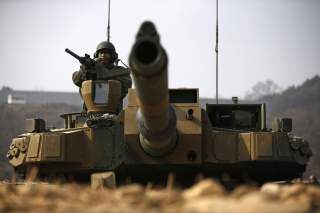North Korea's Not-So-Secret War That Could Have Ignited World War III
North Korea began expanding the infrastructure for its revolutionary campaign as early as 1965.
Along the DMZ, Foot Reconnaissance stations collected intelligence on U.S. and South Korean forces guarding the other side of the border, occasionally provoking firefights but rarely venturing into South Korea itself.
Guerrilla operations fell to the Reconnaissance Bureau and the units under its command. The Bureau’s 124th Army Unit, in particular, would end up carrying out some of the most daring operations throughout the period.
The 124th had evolved out out of a predecessor unit, the 283rd Army Unit. “The 283rd was established in 1965 and had limited success in political operations in South Korea,” says Joseph S. Bermudez, an expert on the North Korean military and intelligence issues. “It was later deactivated and Some of its personnel used to establish absorbed by the 124th Army Unit.”
North Korea also used its relationship with Chosen Soren, an organization of Korean residents living in Japan whose members sometimes carried out intelligence work for Pyongyang, to bank shot agents into the South. It managed the channel primarily through the Ministry of Public Security but sometimes through the Korean Workers’ Party Culture Department, which generally carried out psychological operations and propaganda work.
Reports on Chosen Soren passed to the U.S. by Japanese diplomats in 1969 indicated that North Korean intelligence was using Chosen Soren to disguise the travel and indoctrination of potential agents recruited for intelligence operations in the South.
The reports indicated that Chosen Soren would “capture” South Koreans who had illegally entered Japan while looking to defect to North Korea. Before authorities learned about their presence, members of the group would hide the recruits for a few months and then secretly ship them off to North Korea for “education.”
North Korea would send them back into Japan to present themselves to the authorities, after which they’d be deported back to the ROK for illegally entering the country.
The case of one South Korean man, investigated by Osaka Prefectural Police and the Moriguchi Police Station, shows a variation of the scheme. Japanese police alleged that the 38-year-old factory worker had wanted to defect to North Korea for some time while working in a Korean factory in Saigon, planning to make the trip to the North either through Cambodia or Hong Kong.
During a layover in Osaka on his way home in late January 1969, Japanese authorities alleged that the man decided to defect to North Korea. He found a Chosen Soren school in Osaka where members quickly realized his potential as an agent. After receiving instruction on “the superiority of socialism,” the report alleges that Chosen Soren members forced the man to abandon his plans to defect and instead to return home to foment revolution there.
Armed with a cover story to hide his association with the group, the man reported himself to Japanese officials, was arrested, sentenced to 10 months of penal servitude and deported back to South Korea in lieu of serving out his sentence.
Before the Storm:
1967 would end with a sharp increase in North Korean attacks against U.N. and American troops. North Korean agents had also begun sabotage operations, damaging two South Korean railways in September.
But it was only a prelude for what Pyongyang had in store for its neighbor to the south. In December, Kim Il-sung would once again pledge to forcibly reunify the Korean peninsula. Within a matter of weeks, the North would set it motion its most dramatic effort to fulfill that promise.
This first appeared in WarIsBoring here.
Image: Reuters.

